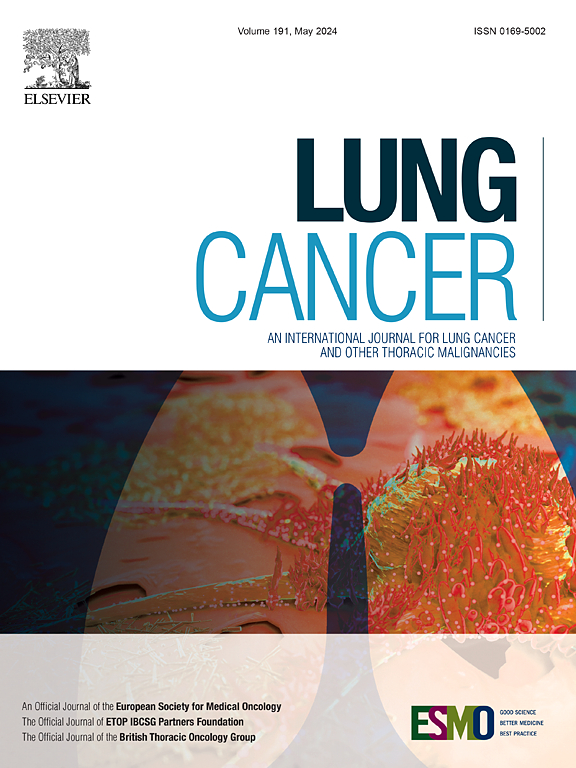机器人辅助支气管镜对原发性肺腺癌的组织病理学分型研究
IF 4.4
2区 医学
Q1 ONCOLOGY
引用次数: 0
摘要
背景:在活检标本上鉴别浸润性原发性肺腺癌的高级别模式和粘液特征对疾病所有阶段的治疗决策具有重要意义。形状传感机器人辅助支气管镜检查(ssRAB)是肺癌伴随诊断和分期的一种新兴模式。我们评估了ssRAB在腺癌模式识别方面的表现,特别是高级别模式,以及活检和手术切除标本之间的组织病理学一致性。方法分析2019年10月至2023年12月期间通过ssRAB钳或冷冻活检标本诊断为肺腺癌的患者。活检标本进行评估,以确定组织病理模式和粘液特征。广义线性混合模型量化了术前和术中因素与活检成功模式识别之间的关系。确定ssrab获得性活检的高级别模式和粘液特征与随后手术切除的低分化级别和粘液特征之间的一致性。结果242份获得ssrab抗体的标本纳入最终分析。活检标本足以确定71%的腺癌组织病理学模式。在多变量分析中,低温活检取样与模式识别呈正相关(OR 3.54, CI: 1.02-12.30;P = 0.04),与钳活检比较。66例有相应的手术切除标本。活检对低分化腺癌术前检测的敏感性、特异性、阳性预测值和阴性预测值分别为63%、72%、61%和74%,对粘液特征术前检测的敏感性、特异性、阳性预测值和阴性预测值分别为87%、100%、100%和96%。本研究首次报道了ssrab获得性活检在鉴别腺癌类型及其与手术切除的一致性方面的表现。我们的发现与先前报道的经皮肺活检一致。ssRAB成为鉴定腺癌类型的可行工具。未来的研究需要在更大的患者群体中证实这些发现。本文章由计算机程序翻译,如有差异,请以英文原文为准。
Robotic-assisted bronchoscopy for histopathologic subtyping of primary lung adenocarcinoma
Background
The identification of high-grade patterns and mucinous features of invasive primary lung adenocarcinoma on biopsy specimens can have implications on therapeutic decisions across all stages of disease. Shape sensing robotic-assisted bronchoscopy (ssRAB) is an emerging modality for the concomitant diagnosis and staging of lung cancer. We evaluated the performance of ssRAB for adenocarcinoma pattern identification, and particularly high-grade patterns, as well as the histopathologic concordance between biopsy and surgical resection specimens.
Methods
Patients with lung adenocarcinoma diagnosed via ssRAB forceps or cryobiopsy specimens between October 2019 and December 2023 were included in the analysis. Biopsy specimens were evaluated for the identification of histopathologic patterns and mucinous features. A generalized linear mixed model quantified the association between pre- and intra-operative factors and successful pattern identification on biopsy. The concordance between high-grade patterns and mucinous features on ssRAB-acquired biopsy and poorly differentiated grade and mucinous features on subsequent surgical resection was determined.
Results
A total of 242 ssRAB-acquired specimens were included in the final analysis. The biopsy specimen was sufficient to identify adenocarcinoma histopathologic patterns in 71 %. In a multivariable analysis, sampling by cryobiopsy was positively associated with pattern identification (OR 3.54, CI: 1.02–12.30; P = 0.04), as compared with forceps biopsy. A corresponding surgical resection specimen was available in 66 cases. The sensitivity, specificity, positive, and negative predictive values of biopsy were 63, 72, 61, and 74 %, respectively for the presurgical detection of poorly differentiated adenocarcinoma, and 87, 100, 100, and 96 %, respectively for the presurgical detection of mucinous features.
Conclusion
This study is the first to report the performance of ssRAB-acquired biopsy for identification of adenocarcinoma patterns and its concordance with surgical resection. Our findings align with those previously reported for percutaneous lung biopsy. ssRAB emerges as a viable tool for the identification of adenocarcinoma patterns. Future studies are needed to confirm these findings in larger patient cohorts.
求助全文
通过发布文献求助,成功后即可免费获取论文全文。
去求助
来源期刊

Lung Cancer
医学-呼吸系统
CiteScore
9.40
自引率
3.80%
发文量
407
审稿时长
25 days
期刊介绍:
Lung Cancer is an international publication covering the clinical, translational and basic science of malignancies of the lung and chest region.Original research articles, early reports, review articles, editorials and correspondence covering the prevention, epidemiology and etiology, basic biology, pathology, clinical assessment, surgery, chemotherapy, radiotherapy, combined treatment modalities, other treatment modalities and outcomes of lung cancer are welcome.
 求助内容:
求助内容: 应助结果提醒方式:
应助结果提醒方式:


